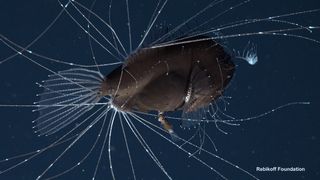This Mysterious Deep-Sea Creature Has Never Been Seen Alive Before. Until Now.
In the deep North Atlantic, a small but ghastly-looking female anglerfish floats in the inky-black waters, eerily lit by her wispy, glowing fishing lure and the specks of light illuminating her long fin rays.
Her ghostly glow reveals she isn't alone. Attached to her underside, her tiny "husband" — a parasitic mate that had fused himself to her belly — wafts in the water.
German researchers Kirsten and Joachim Jakobsen filmed this extraordinary scene with the Lula 1000, a deep-sea submersible diving off the coast of São Jorge Island in the Azores, about 850 miles (1,360 kilometers) west of Portugal. [In Photos: Spooky Deep-Sea Creatures]
Until now, researchers had never seen this species of anglerfish (Caulophryne jordani) alive. But the 25-minute-long video, taken at about 2,600 feet (800 meters) underwater, changes that.

"This is a unique and never-before-seen thing," Ted Pietsch, a professor emeritus of aquatic and fishery sciences and curator emeritus of fishes at the Burke Museum of Natural History and Culture at the University of Washington, said in a statement.
There are about 160 known anglerfish species that live in all of the world's oceans, but sightings of them are extremely rare. For instance, there are just 14 C. jordani preserved in jars of alcohol around the world, and the male C. jordani has never been seen by human eyes.
Moreover, even though deep-water exploration has taken off, the Lula 1000's video is just the third time researchers have filmed a live anglerfish in the deep ocean, Pietsch said.
Sign up for the Live Science daily newsletter now
Get the world’s most fascinating discoveries delivered straight to your inbox.
Bizarre, glowing fish
The anglerfish is most famous for its bioluminescent fishing apparatus, a lure poking out from its head that it uses to attract prey closer to its pointy teeth. There are few creatures swimming around in this dark zone of the ocean, about 980 feet to 16,400 feet (300 to 5,000 m) deep, but the anglerfish has an expandable stomach and jaws that let it devour prey larger than it is, in a single gulp.
Female and male anglerfish are extremely different: Female anglerfish can grow to be about 60 times larger and half-a-million times heavier than the males. Instead of sporting a luminescent lure, the males have large eyes and huge nostrils, which help them sniff out species-specific scents the females emit.

When a male spots a female, he bites onto her body, allowing their tissues and circulatory systems to fuse. The pair then creates a symbiotic relationship: He gives her sperm, and she gives him an all-you-can eat buffet of nutrients for the rest of their lives.
It's impossible, however, to see this behavior in an aquarium. These deep-sea fish can't survive the pressure and temperature changes they undergo when they're brought up to the ocean's surface, Pietsch said. [Dangers in the Deep: 10 Scariest Sea Creatures]
First of its kind
The video of the glowing fish floating like a tumbleweed in the ocean has revealed new clues about the fish. For instance, almost all fish fin rays — the delicate, thread-like strands that protrude from the fish's body — are connected by membranes, so they all move as a single unit. That's not the case for C. jordani, whose fin rays each move independently, meaning they have their own muscles and nerves, Pietsch said.
"One can't help but think these fin-rays form a network of sensory antennae, a kind of sphere of tactility around the fish — akin to cat whiskers— that functions to monitor the close presence of predators or prey," Pietsch said.
Another never-before-seen detail? The pinpricks of light scattered along the fin rays, which are likely glowing from bioluminescence. (In bioluminescence, an organism or bacteria within the organism produce their ghostly glow through chemical reactions. In contrast, biofluorescent organisms glow when an outside light source shines on them, and they release that light at a lower wavelength.)
The anglerfish's light likely attracts prey, but it may also serve other roles, such as making the fish look big and scary to potential predators, or letting it disguise itself as a jellyfish with stinging tentacles, Pietsch said.
The Jakobsens said they will continue to film deep-sea creatures with the Lula 1000. The submersible is operated by the Rebikoff-Niggeler Foundation, a marine science organization that facilitates deep-sea documentation. You can learn more in this Vimeo video.
Original article on Live Science.

Laura is the archaeology and Life's Little Mysteries editor at Live Science. She also reports on general science, including paleontology. Her work has appeared in The New York Times, Scholastic, Popular Science and Spectrum, a site on autism research. She has won multiple awards from the Society of Professional Journalists and the Washington Newspaper Publishers Association for her reporting at a weekly newspaper near Seattle. Laura holds a bachelor's degree in English literature and psychology from Washington University in St. Louis and a master's degree in science writing from NYU.
Most Popular



